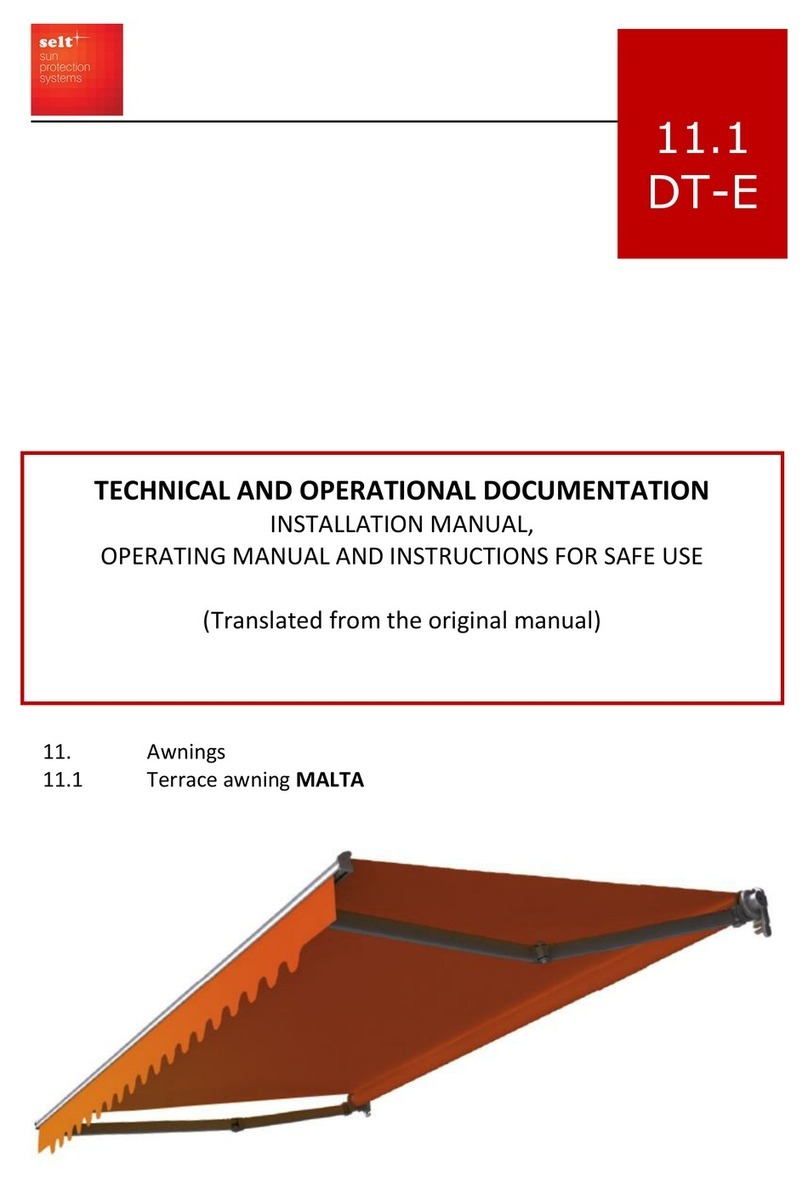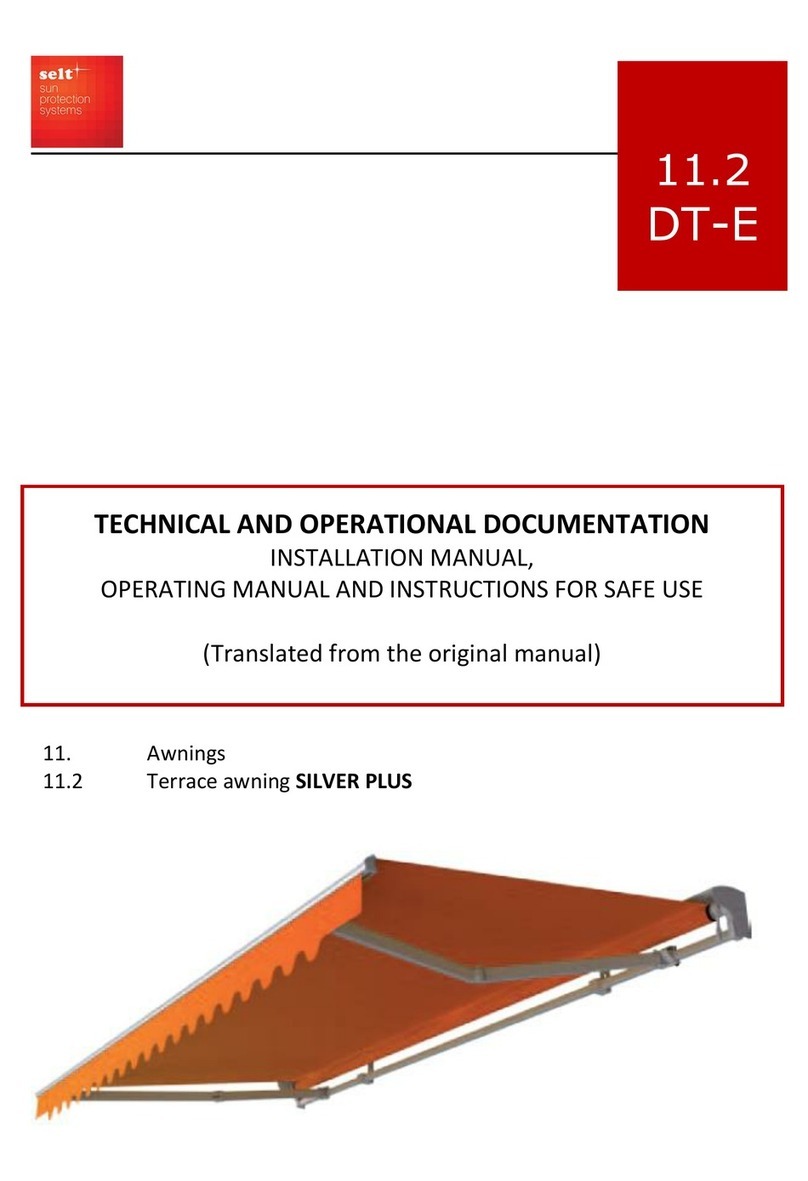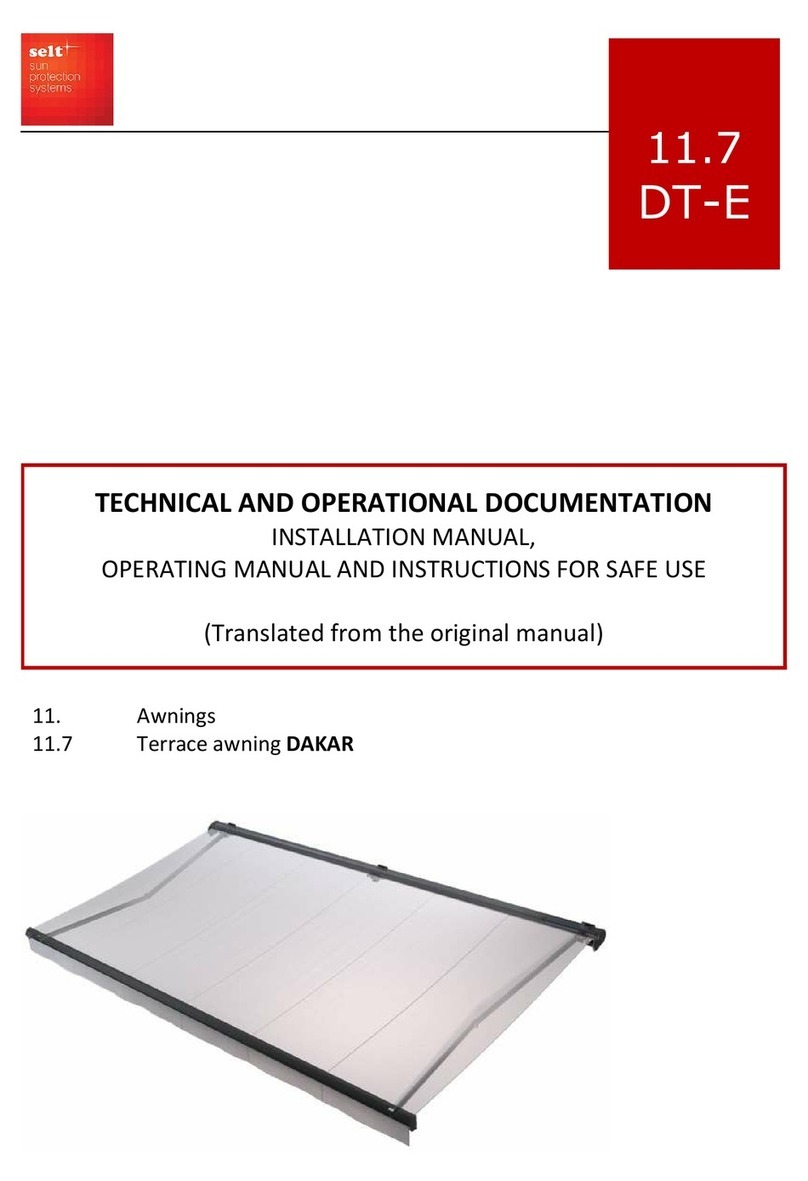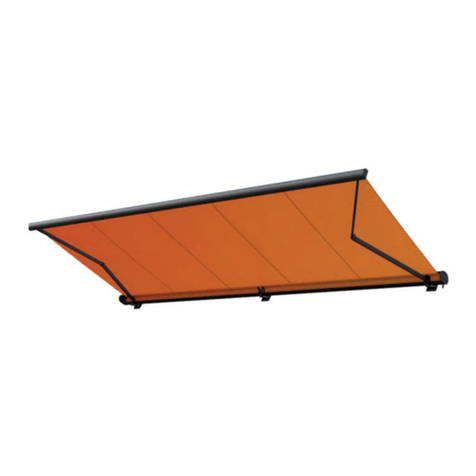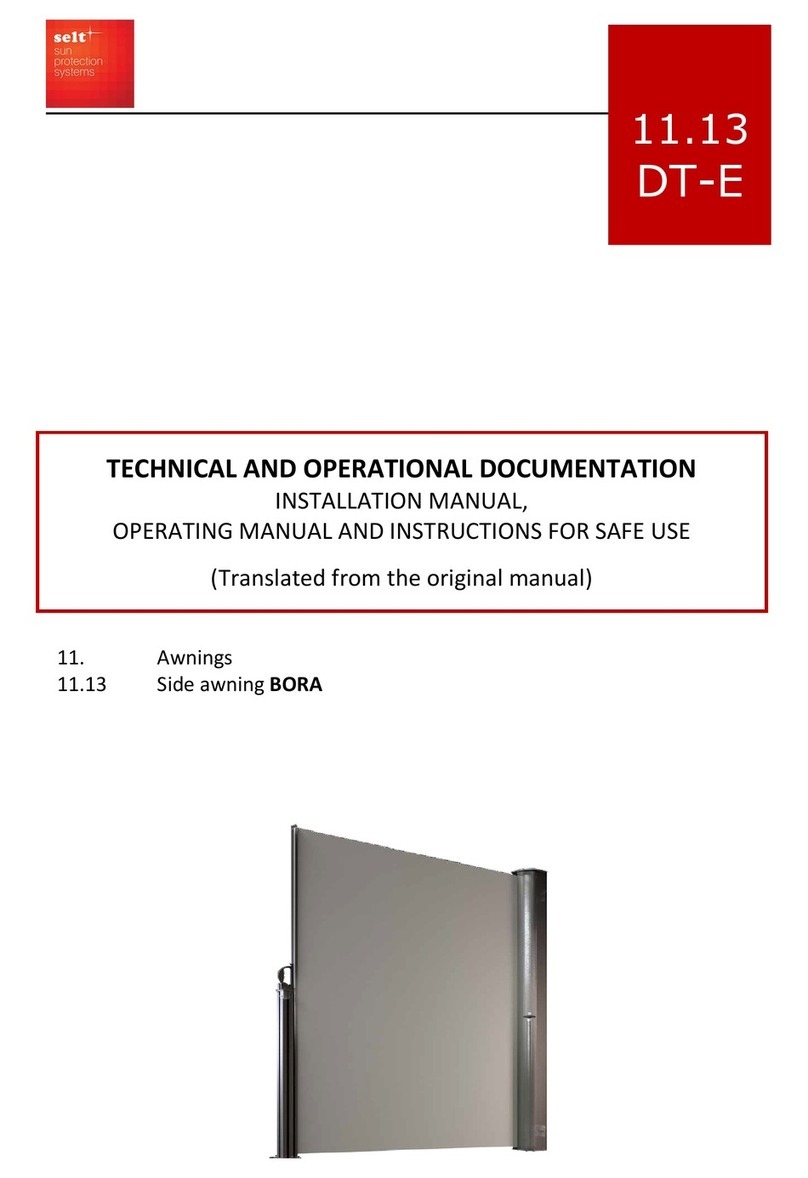SELT AUSTRALIA User manual

OPERATING MANUAL AND INSTRUCTIONS FOR SAFE USE
11. Awnings
11.3 Terrace awning AUSTRALIA
11.3.1 Installation manual
Documentation no. 11.3.1 –EN
TECHNICAL AND OPERATIONAL DOCUMENTATION
INSTALLATION MANUAL,
11.5
DTE

DT-E 11.3.1 TERRACE AWNING AUSTRALIA
Edition: March 2016, Issue 1
English
page 2 / 28
PRODUCT NAME:
TERRACE AWNING
PALLADIO
PRODUCT MANUFACTURER’S MARKING:
Manufacturer’s name:
SELT Sp. z o. o.
Manufacturer’s registered office:
45- 449 Opole, ul. Wschodnia 23A
Contact details:
Tel: +48 77 553 21 00 (secretariat)
Fax: +48 77 553 22 00
Website:
www.selt.com
E-mail:
PRODUCT SAFETY MARKING:
The product meets the CE safety requirements.
THIS TECHNICAL AND OPERATIONAL DOCUMENTATION:
Is valid from: 28 March 2022
Is applicable to the above listed product versions.

DT-E 11.3.1 TERRACE AWNING AUSTRALIA
Edition: March 2016, Issue 1
English
page 3 / 28
Table of contents
TABLE OF CONTENTS
TABLE OF CONTENTS 3
1 INTRODUCTION 4
1.1 SAFETY GUIDELINES FOR THE PRODUCT................................................................................................................. 4
1.2 EXPLANATION OF SYMBOLS AND SIGNS ................................................................................................................. 4
1.3 TERMS AND DEFINITIONS ....................................................................................................................................... 5
1.4 SUBJECT, INTENDED USE AND CONTENTS OF THE DOCUMENTATION................................................................... 5
2 PRODUCT TECHNICAL INFORMATION 6
2.1 TECHNICAL PARAMETERS ....................................................................................................................................... 6
2.2 PRODUCT SPECIFICATION ....................................................................................................................................... 6
2.3 PALLADIO AWNING CONSTRUCTION ...................................................................Błąd! Nie zdefiniowano zakładki.
2.4 TYPE OF BRACKETS.................................................................................................................................................. 7
3 TRANSPORT AND STORAGE OF THE PRODUCT 8
3.1 COMPLETENESS AND QUALITY CONDITION OF DELIVERY ...................................................................................... 8
3.2 GENERAL CONDITIONS FOR TRANSPORT AND STORAGE OF THE PRODUCT .......................................................... 8
3.3 OBLIGATORY DESCRIPTIONS TO BE PLACED ON THE PRODUCT PACKAGING ......................................................... 8
4 PRODUCT INSTALLATION 8
4.1 REQUIREMENTS FOR SAFE INSTALLATION OF THE PRODUCT AT HEIGHTS............................................................. 9
4.2 PREPARATION FOR INSTALLATION.......................................................................................................................... 9
4.3 GENERAL REQUIREMENTS FOR SAFE INSTALLATION ............................................................................................ 10
4.4 INSTALLATION TOOLS ........................................................................................................................................... 10
4.5 INSTALLATION....................................................................................................................................................... 10
4.5.1 PALLADIO AWNING INSTALLATION –WALL BRACKETS................................................................................ 10
4.5.2 PALLADIO AWNING INSTALLATION –CEILING BRACKET ............................................................................. 14
4.5.3 PALLADIO AWNING INSTALLATION –ROOF RAFTER BRACKET.................................................................... 15
4.6 ELECTRIC DRIVE..................................................................................................................................................... 15
4.6.1 CONNECTION TO ELECTRICAL INSTALLATION ............................................................................................. 15
4.6.2 REMOTE OPERATION................................................................................................................................... 16
4.6.3 START-UP AND ADJUSTMENT...................................................................................................................... 16
4.7 MANUAL DRIVE..................................................................................................................................................... 17
5 SYSTEM OPERATION AND PRODUCT SAFETY 17
5.1 GENERAL REQUIREMENTS FOR OCCUPATIONAL HEALTH AND SAFETY................................................................ 17
5.2 SAFETY REQUIREMENTS RELATED TO SPECIAL CONDITIONS AND PLACES OF PRODUCT USE.............................. 18
5.3 OPERATIONAL SAFETY........................................................................................................................................... 18
5.4 CONTROL OF SAFE USE OF THE PRODUCT ............................................................................................................ 19
6 SYSTEM USE AND MAINTENANCE 19
6.1 USING THE PRODUCT IN ACCORDANCE WITH ITS INTENDED USE........................................................................ 19
6.2 INSTRUCTION FOR NON-PROFESSIONALS............................................................................................................. 20
6.3 TECHNICAL INSPECTIONS, MAINTENANCE AND REPAIR ....................................................................................... 20
6.4 USE OF AWNING FABRICS ..................................................................................................................................... 21
7 GENERAL WARRANTY TERMS 23
7.1 WARRANTY EXCLUSIONS ...................................................................................................................................... 23
8 COMPLAINT / TECHNICAL DEFECTS 25
8.1 COMPLAINTS......................................................................................................................................................... 25
8.2 TECHNICAL DEFECTS ............................................................................................................................................. 25
9 PRODUCT DISASSEMBLY / UTILISATION / DISPOSAL 25
10 MARKING AND LABELLING OF THE PRODUCT WITH CE MARK 27
10.1 PRODUCT COMPLIANCE WITH THE CE STANDARD .......................................................................................... 27
10.2 INFORMATION ACCOMPANYING THE CE MARKING ........................................................................................ 27

DT-E 11.3.1 TERRACE AWNING AUSTRALIA
Edition: March 2016, Issue 1
English
page 4 / 28
1. INTRODUCTION
1.1 SAFETY GUIDELINES FOR THE PRODUCT
The product has been manufactured in accordance with the latest technical knowledge in the field of construction and
manufacturing and meets the safety requirements in accordance with the following standards.
The safe construction of the product was achieved thanks to:
No.
Subject
European legal basis
Polish legal basis
1
External blinds. Performance
requirements including safety
EN 13561:2015
PN-EN 13561:2015
2
Construction Products
Regulation (CPR)
Regulation (EU) no 305/2011 of
the European Parliament and of
the Council
Act of April 16, 2004 on building products
DZ. U [Journal of Laws] 2004, No. 92, item
881 as amended of (Dz.U. [Journal of Laws]
2016.1570; 2015.1165; 2016.542)
3
Essential requirements for
machines
Directive 2006/42/EC of the
European Parliament and the
Council
Resolution of the Minister of Economy of 21
October 2008 DZ.U. [Journal of Laws] 2008
No. 199 item 1228) 1228 as amended (Dz.U.
Journal of Laws 2011.124)
Related documents: Declaration of Performance, Declaration of Conformity (only products with motor) and
instructions for installation, use of motors and control.
1.2 EXPLANATION OF SYMBOLS AND SIGNS
The following symbols (pictograms) indicate particularly important threats and safety information.
Pictogram
Pictogram meaning
Information
INFORMATION
Prior to using the product, its operating manual should be read.
Following the operating manual guarantees:
- failure-free use of the product,
- warranty coverage against product defects
Keep the operating manual for safety of people.
INFORMATION
No harmful or dangerous consequences for people or facilities.
NOTE!
A situation likely to cause product damage or other damage.
No threat for people.
WARNING!
Threat of danger
DANGER!
This symbol marks all safety information which, if not observed, could endanger
the life or health of persons. Health or life hazard. Risk: danger of serious injury
or death. Unsafe operation that may cause injury or damage to the product.
WARNING!
Threat to human life or health due to electric shock.
ENVIRONMENT
Marking of electronic or electric equipment, which should be collected in the
designated points.

DT-E 11.3.1 TERRACE AWNING AUSTRALIA
Edition: March 2016, Issue 1
English
page 5 / 28
1.3 TERMS AND DEFINITIONS
For the purposes of this documentation the following terms and definitions shall apply:
AWNING: Terrace awnings, as external sun protection screens are installed solely on the outside of the building for
protection from sun light for terraces, restaurant patios, balconies, shop windows etc. Rolling up and down of the awning
fabric is performed with the use of an electric control mechanism or manual crank.
AWNING FABRIC: Part of the product serving for protection from sun light, but also having a decorative function.
Manufactured from high quality materials is put into motion with manual or electric control mechanism, assuring the
product fulfills its function.
1.4 SUBJECT, INTENDED USE AND CONTENTS OF THE DOCUMENTATION
This documentation covers the products manufactured by SELT Sp. z o.o.
This documentation applies to all types of terrace awning Palladio.
User’s manual and instructions for safe use, with motor manual, should be handed over to the end
user.
IMPORTANT INSTRUCTION RELATED TO SAFETY
WARNING - IT IS VERY IMPORTANT TO PROCEED ACCORDING TO THIS MANUAL
TO ENSURE PEOPLE SAFETY.
KEEP THIS MANUAL
The documentation is valid jointly with the information concerning a specific product, which is available
on the website www.selt.com
This documentation includes:
important recommendations concerning product installation, use and maintenance.
important recommendations concerning product transport and storage.
tips following which will assure long-time and fault-free use of the product.
SELT SP. Z O.O. shall not bear responsibility for damage resulting from failure to follow recommendations included in the
documentation.
In order to further improve the product, SELT SP. Z O.O. reserves the right to introduce changes which, while maintaining
the essential technical parameters, shall be deemed purposeful for improving product operation quality and safety of use.
SELT SP. Z O.O. with a head office in Opole shall hold the copyrights to this documentation. The documentation cannot be
used without permission, either partially or as a whole, for any concurrent business activity nor can it be made available to
third parties.
This manual suits for next models
1
Table of contents
Other SELT Accessories manuals
